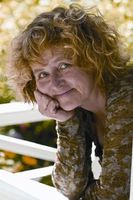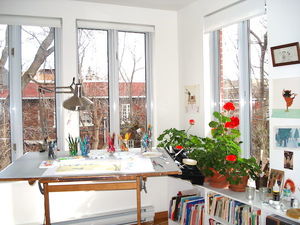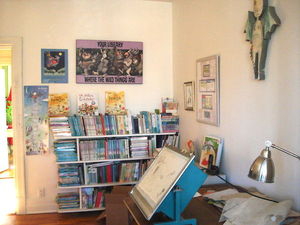At the Desk, with Marie-Louise Gay
Marie-Louise Gay is based in Montreal but beloved around the world for her warm, funny, fabulously creative children's books, especially the Stella and Sam series. She has racked up a bevy of awards to prove it, including the prestigious Marilyn Baillie and Vicky Metcalf Awards, as well as being nominated for the Hans Christian Andersen Award.
Her latest offering is the beautifully illustrated Short Stories for Little Monsters (Groundwood Books), which is chock full of the kinds of (wonderfully bizarre) questions that will feel familiar to anyone with kids in their life. From "what do trees talk about?" to "do worms rule the world?" Short Stories for Little Monsters is a celebration of the weird wonder of being a kid, and deliciously funny to boot.
To celebrate Short Stories for Little Monsters, we've asked Marie-Louise to take us into the space where her unique picture books are born. She tells us about life on an urban island, her furry muse, and re-purposing church furniture for art.
At the Desk with Marie-Louise Gay
I live and work on an island.
Not a deserted island but a large, urban, bustling, chaotic island. A city-island floating on the St. Lawrence River, bearing people and buildings, churches and trees and a small, green round-shouldered mountain which, in another life, was a fiery volcano. If you stand on the mountain's bald spot, you can see old iron bridges crossing the water like spiderwebs, tying my city to the mainland and the rest of the world. From my studio, which is a smaller island within the city-island, I don't see or smell water, instead I look out on trees and small gardens, red brick houses and children running wild in the alleyway, but the knowledge of living on an island is always at the back of my mind. I've always been fascinated by the sea and often dream that my island will sail down the river to the Atlantic Ocean one day, pencils and paintbrushes rolling off my drawing table, waves splashing at my windows where my cat sits staring at the pelicans perched on my neighbour's rooftops.
Now you see where my mind wanders when I am supposed to be writing and illustrating my next book.
My studio is on the second floor of our house. Two small rooms, one opening onto the other like two train carriages. The room where I write, paint and draw has large windows that let in a lot of natural light, which is necessary for my painting and drawing. These rooms have a door that is firmly shut. I need to be alone to write and draw. I cannot even imagine sharing a studio space with other people... my concentration would fly out the window. The only beast that manages to sneak his way in is my inspiring and distracting muse, our house cat.
My old drawing table sits in the middle of the room. I am surrounded by bookshelves which hold hundreds of children's books old and new, as well as encyclopedias and reference books about animals, birds, insects, architecture, trees, anatomy, my favourite artists' and illustrators' painting techniques, etc...
There are shelves dedicated to my notebooks of ideas, inspirations, unfinished stories, poems, great first sentences, sketches, storyboards, travel journals. They are of every shape and size, some of them thirty years old.
I never throw anything away... maybe an idea can be recycled, revamped... maybe that perfect sentence that I couldn't place in one story will find its home into another...
Your CanLit News
Subscribe to Open Book’s newsletter to get local book events, literary content, writing tips, and more in your inbox
Since I create my illustrations manually for the sheer pleasure of sketching with a pencil, dabbling in colours, glueing and pasting, erasing, starting over and discovering through trial and error lovely mistakes that enhance my creative process, I am also surrounded by my art materials: boxes and tubes of watercolours, acrylics, gouache, bottles of ink, jars of coloured pencils, paintbrushes big and small.
One wall in my studio is constellated by hundreds of pinpricks since I pin up my references, thumbnails, storyboards, sketches and all my original artwork as my current project progresses. I need to see the visual rhythm of the book I am working on. On the other walls, a changing array of illustrations that inspire me. At the moment, art by Wolf Erlbruch, Virginie Egger, Isabelle Arsenault, Manon Gauthier, Shaun Tan, Maurice Sendak and Rosemary Wells.
In the second room, there is a huge old wooden cabinet, about two meters long, with wide, deep drawers. A hundred years ago, this piece of furniture would have been in a church's vestry. In it, priests would have stored their sacerdotal garments and religious artefacts. I use it to store my watercolour papers as well as sheets of coloured, textured and printed paper that I use in my collages... I also store my original drawings that have been published (the ones that I have left), my original annotated manuscripts and my correspondence with publishers.
There is also my lightbox to retrace and rework my drawings. One large crammed bookcase holds all the first editions of my books, as well as the foreign editions in, at last count, some twenty languages.
I have put my computer in another room downstairs to keep the business part of my work separate from the creative part.
And that is my island.
________________________________________
Marie-Louise Gay has achieved international acclaim as an author and illustrator of children’s books. She has won many awards, including two Governor General’s Literary awards, the Elizabeth Mrazik-Cleaver Award, the Vicky Metcalf Award, and the Marilyn Baillie Picture Book Award. She has also been nominated for the prestigious Astrid Lindgren Memorial Award and the Hans Christian Andersen Award. Marie-Louise’s very popular Stella and Sam series has been translated into more than fifteen languages and is loved by children all over the world. She lives in Montreal.






